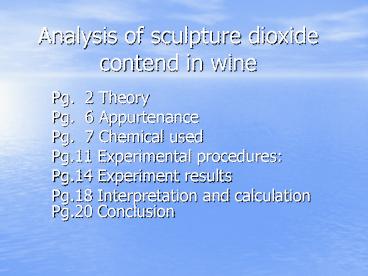Analysis of sculpture dioxide contend in wine - PowerPoint PPT Presentation
1 / 21
Title:
Analysis of sculpture dioxide contend in wine
Description:
Analysis of sculpture dioxide contend in wine. Pg. 2 Theory. Pg. 6 Appurtenance. Pg. 7 Chemical used. Pg.11 Experimental procedures: Pg.14 Experiment results ... – PowerPoint PPT presentation
Number of Views:62
Avg rating:3.0/5.0
Title: Analysis of sculpture dioxide contend in wine
1
Analysis of sculpture dioxide contend in wine
- Pg. 2 Theory
- Pg. 6 Appurtenance
- Pg. 7 Chemical used
- Pg.11 Experimental procedures
- Pg.14 Experiment results
- Pg.18 Interpretation and calculationPg.20
Conclusion
2
Theory
- The alcohol content of wine (e.g. ethanol) can be
oxidised by atmospheric oxygen to ethanoic acid
which makes the wines taste sour and unpalatable.
To reduce or minimize the rate of oxidation of
alcohol content, a small amount of antioxidant
should be added. One of the examples is sulphur
dioxide.
3
- Free Sulphur dioxide destroys bacteria which may
cause unwanted secondary fermentation. It also
helps to preserve the qualities of wines. The
subtle aromas and taste sensations of human come
from complex organic molecules. Many of these are
fragile, because they tend to become oxidised.
Sulphur dioxide prevents this by reacting with
the oxygen and interfering with the action of
enzymes which catalyse oxidation. On the other
hand, most of the wine contained sodium
hydrogensulphate (NaHSO3), a form of SO2.
4
- In this experiment, the amount of total
available sulphur dioxide in the wine sample,
irrespective of the form, is determined. The
method involves the addition of acid to convert
all SO2 into SO32- ion which is then titrated
with iodine solution.
5
Equation
- SO32- (aq) 2H (aq) ? SO2 (aq) H2O (aq)
- SO2 (aq) I2 (aq) 2H2O (aq) ?2HI (aq) H2SO4
(aq)
6
Apparatus
7
Chemicals used
- White wine sample x 2
8
100 cm3 0.005 M iodine solution
9
100 cm3 1 M sodium hydroxide solution
10
fresh starch solution
11
100 cm3 2M sulphuric acid
12
Experimental procedures
- a) The volume of wine in the bottle was recorded
from the label. - b) 25cm3 of wine was transferred to a conical
flask. - c) Approximately 12cm3 of 1M sodium hydroxide
soluton was added to the conical flask to
neutralize the ethanoic acid in the wine and the
conical flask was left for 15 minutes.
13
- d) About 10cm3 of 2M sulphuric acid solution
was added to the mixture and then a few drops of
starch solution were added . The solution was
quickly titrated with 0.005M iodine solution. - e) The actual molarity of the iodine solution and
also the volume of iodine solution needed to
produce the first faint but permanent blur colour
were recorded.
14
- f) The titration was repeated until 2 or 3
sufficiently close results were obtained. - g) The above steps were repeated for another
sample of wine.
15
Experiment results
- Brand A Brand B
16
Brand A
- Average volume of I2 used (0.30 0.30 0.20)
/ 3 - 0.27cm3
17
Brand B
- Average volume of I2 used (1.80 1.80 1.90)
/ 3 - 1.83cm3
18
Interpretation and calculation
- Brand A
- Number of moles of I2 in 25cm3 0.005 (0.27 /
1000) - 1.35x10-6 mol
- 1 mole of SO2 reacts with 1 mole of I2
- no. of moles of SO2 in 25cm3 1.35x10-6 mol
- no. of moles of SO2 in 560cm3 1.35x10-6 (22.4)
- 3.024x10-5 mol
- conc. of SO2 in brand A wine 3.024x10-5 (64)
(1000) / (560 / 1000) - 3.456 mg dm3
19
- Brand B
- Number of moles of I2 in 25cm3 0.005 (1.83 /
1000) - 9.15x10-6 mol
- 1 mole of SO2 reacts with 1 mole of I2
- no. of moles of SO2 in 25cm3 9.15x10-6 mol
- no. of moles of SO2 in 750cm3 9.15x10-6 (30)
- 2.745x10-4 mol
- conc. of SO2 in brand B wine 2.745x10-4(64)
(1000) / (750 / 1000) - 23.424 mg dm-3
20
Conclusion
- In this experiment, the concentrations of sulphur
dioxide presented in Brand A, Pearl River
Kwanling Mijin and Brand B, Boone's Delicious
Apple are 3.456 mg dm-3 - and 23.424 mg dm-3 respectively.
21
constructor
- Chan Tak Hong
- Ng Wai Lok
- Cheung Kai Wha
- 6A Group































